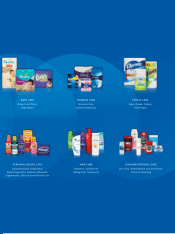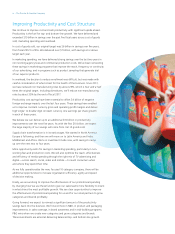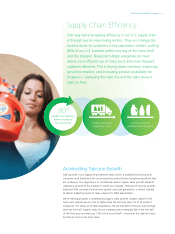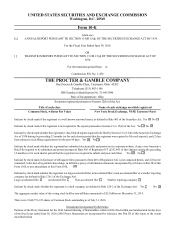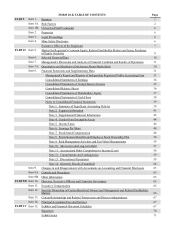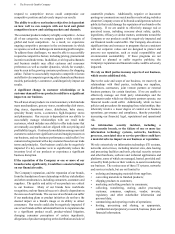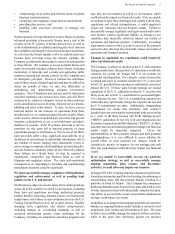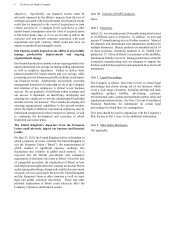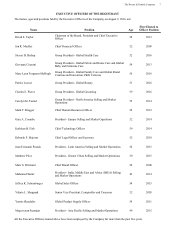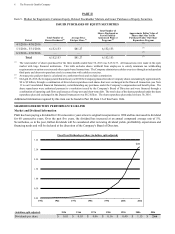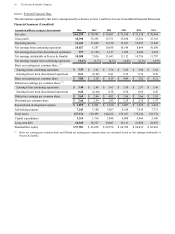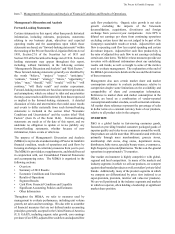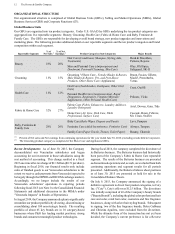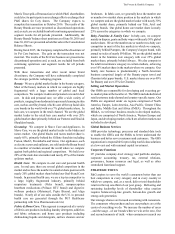Proctor and Gamble 2016 Annual Report Download - page 17
Download and view the complete annual report
Please find page 17 of the 2016 Proctor and Gamble annual report below. You can navigate through the pages in the report by either clicking on the pages listed below, or by using the keyword search tool below to find specific information within the annual report.The Procter & Gamble Company 3
Our business is subject to numerous risks as a result of our
having significant operations and sales in international
markets, including foreign currency fluctuations, currency
exchange or pricing controls and localized volatility.
We are a global company, with operations in approximately 70
countries and products sold in more than 180 countries and
territories around the world. We hold assets, incur liabilities,
earn revenues and pay expenses in a variety of currencies other
than the U.S. dollar, and our operations outside the U.S.
generate a significant portion of our net revenue. Fluctuations
in exchange rates for foreign currencies, such as the recent
volatility in the Russian ruble, may reduce the U.S. dollar value
of revenues, profits and cash flows we receive from non-U.S.
markets, increase our supply costs (as measured in U.S. dollars)
in those markets, negatively impact our competitiveness in
those markets or otherwise adversely impact our business
results or financial condition. Moreover, discriminatory or
conflicting fiscal policies in different countries could adversely
affect our results. See also the Results of Operations and Cash
Flow, Financial Condition and Liquidity sections of the MD&A
and Note 9 to our Consolidated Financial Statements.
We also have sizable businesses and maintain local currency
cash balances in a number of foreign countries with exchange,
import authorization, pricing or other controls, including
Argentina, Egypt, Nigeria and Ukraine. Our results of
operations and financial condition could be adversely impacted
if we are unable to successfully manage such controls, continue
existing business operations and repatriate earnings from
overseas, or if new or increased tariffs, quotas, exchange or
price controls, trade barriers or similar restrictions are imposed
on our business outside the U.S.
Additionally, our business, operations or employees may be
adversely affected by political volatility, labor market
disruptions or other crises or vulnerabilities in individual
countries or regions, including political instability or upheaval,
broad economic instability or sovereign risk related to a default
by or deterioration in the credit worthiness of local
governments, particularly in emerging markets.
Uncertain global economic conditions may adversely
impact demand for our products or cause our customers
and other business partners to suffer financial hardship,
which could adversely impact our business.
Our business could be negatively impacted by reduced demand
for our products related to one or more significant local,
regional or global economic disruptions, such as: a slow-down
in the general economy; reduced market growth rates; tighter
credit markets for our suppliers, vendors or customers; or the
inability to conduct day-to-day transactions through our
financial intermediaries to pay funds to or collect funds from
our customers, vendors and suppliers. Additionally, economic
conditions may cause our suppliers, distributors, contractors
or other third party partners to suffer financial difficulties that
they cannot overcome, resulting in their inability to provide us
with the materials and services we need, in which case our
business and results of operations could be adversely affected.
Customers may also suffer financial hardships due to economic
conditions such that their accounts become uncollectible or are
subject to longer collection cycles. If we are unable to generate
sufficient income and cash flow, it could affect the Company’s
ability to achieve expected share repurchase and dividend
payments.
Disruptions in credit markets or changes to our credit
ratings may reduce our access to credit.
Adisruption in the credit markets or a downgrade of our current
credit rating could increase our future borrowing costs and
impair our ability to access capital and credit markets on terms
commercially acceptable to us, which could adversely affect
our liquidity and capital resources or significantly increase our
cost of capital.
Disruption in our global supply chain may negatively
impact our business results.
Our ability to meet our customers’ needs and achieve cost
targets depends on our ability to maintain key manufacturing
and supply arrangements, including execution of our
previously-announced supply chain simplifications and certain
sole supplier or sole manufacturing plant arrangements. The
loss or disruption of such manufacturing and supply
arrangements, including for issues such as labor disputes, loss
or impairment of key manufacturing sites, inability to procure
sufficient raw or input materials, natural disasters, acts of war
or terrorism or other external factors over which we have no
control, could interrupt product supply and, if not effectively
managed and remedied, have an adverse impact on our
business, financial condition or results of operations.
Our businesses face cost fluctuations and pressures that
could affect our business results.
Our costs are subject to fluctuations, particularly due to
changes in the prices of commodities and raw materials and
the costs of labor, transportation, energy, pension and
healthcare. Therefore, our business results are dependent, in
part, on our continued ability to manage these fluctuations
through pricing actions, cost saving projects and sourcing
decisions, while maintaining and improving margins and
market share. Failure to manage these fluctuations could
adversely impact our financial results.
Our ability to meet our growth targets depends on
successful product, marketing and operations innovation
and successful responses to competitive innovation.
We are a consumer products company that relies on continued
global demand for our brands and products. Achieving our
business results depends, in part, on successfully developing,
introducing and marketing new products and on making
significant improvements to our equipment and manufacturing
processes. The success of such innovation depends on our
ability to correctly anticipate customer and consumer
acceptance and trends, to obtain, maintain and enforce
necessary intellectual property protections and to avoid
infringing upon the intellectual property rights of others. We
must also be able to successfully respond to technological
advances made by, and intellectual property rights granted to,
competitors. Failure to continually innovate, improve and


